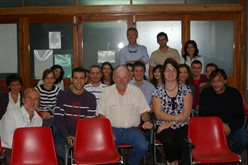Blackland Research and Extension Center Scientists Team up with Italian Scientists
December 2008
A year ago this past October, six scientists from different parts of Italy journeyed to Temple, Texas for two weeks to learn the ins and outs of the WinEPIC and EPICcrop simulation models. EPIC is a field-scale crop simulation model designed to simulate the interaction of natural resources (soil, water and climate) and crop management practices to estimate impacts on harvested crop yield, soil properties, soil erosion, profitability and nutrient/pesticide fate. WinEPIC is a Windows interface to the EPIC model designed to help agricultural practitioners optimize crop management and maximize production and profit, to identify limitations to crop yield, to assist growers in replant decisions, and to identify best management practices that minimize impact of agriculture on soil erosion and water quality. During their two-week stay at the research center, the scientists focused their attention on the simulation of corn, sunflowers, grapes and grassland production as well as the effects of climate change on these cropping systems.
That one visit has blossomed into a working relationship between the Blackland Research Center and agricultural research centers across Italy from Sassari to Rome to Ancona to Foggia. In the past year scientists from Temple have worked with scientists from the various parts of Italy to simulate crop growth of sunflowers, corn, durum wheat and various grassland/pasture scenarios.

Dr. Jimmy Williams and Evelyn Steglich (front center) were invited to lecture on the EPIC crop simulation model to a group of graduate students and faculty at the University of Sassari, Italy as part of a “Visiting Scientist” program funded by the University of Sassari.
Luca Doro, a scientist from Sassari, has been using the WinEPIC model as part of his doctoral dissertation in which he is simulating the long term changes in soil carbon for grassland and pasture scenarios being grazed by dairy sheep. He will also use the model to simulate the effects of climate change on these cropping systems.
This past September Dr. Jimmy Williams, hydrologist and agricultural engineer, and Evelyn Steglich, agronomist, from the Blackland Research and Extension Center, Temple were invited to spend two weeks at the University of Sassari, Italy as part of a “Visiting Scientist” program available through the University of Sassari. While at the university, Williams and Steglich presented three lectures to graduate students and faculty of the university’s agronomy department. These lectures described the various features of the EPIC model and served as a demonstration of select features of the WinEPIC model interface. Also while at the university, Williams and Steglich worked with graduate students and faculty using the model for dissertation work to assist them in better simulating their measured data.
Beginning in January 2009 Dr. Luca Doro and Dr. Roberto Orsini from Sassari, Italy and Ancona, Italy, respectively will be spending six months at the Blackland Research and Extension Center as part of a program called “Master and Back” funded by the University of Sassari. While here they will work with Jimmy Williams, Evelyn Steglich and Armen Kemanian to gain a more in-depth understanding of the EPIC model as well as work with the Temple scientists to improve the grazing aspects of the model. Dr. Roberto Orsini from Ancona will also be using the APEX model, a small watershed model similar to EPIC also developed by Dr. Williams, to simulate an extensive 10-year water erosion study near Ancona, Italy. He will be simulating nitrate and phosphorus runoff as well as soil losses due to water erosion. Once he has calibrated the model using his measured data, he will use the model to simulate climate change scenarios on current cropping systems and adaptation strategies and/or prescriptions for agro-environment systems.
It is the hopes of all involved that this collaboration will continue to grow and benefit the scientists of both countries.
